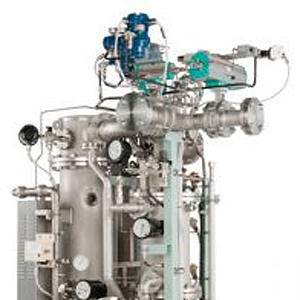Functions and Applications of Mitsubishi VOS Ballast Water Treatment System
Blog | February 15th, 2017 
Mitsubishi VOS ballast water treatment systems are designed to stop the spread of invasive marine organisms. Certainly, every large seagoing vessel needs to pump in ballast to provide floating stability, but the watery reservoir must not serve as a handy environment for localized aquatic lifeforms. Fortunately, the VOS process stops non-indigenous organisms from using ballast compartments as a hitchhiking haven. It all begins with the venturi oxygenation stripping mechanism.
Venturi Oxygenation Stripping: A Primer
International authorities and national conservation agencies are seeing a worrying rise in invasive marine species. Concern has reached the point that the IMO (International Maritime Organization) has taken action in the form of a Ballast Water Management Convention. Of course, climate changes are responsible for some of this oceanic immigration, but our seagoing vessels must also accept their share of the blame. The Mitsubishi VOS ballast water treatment system provides a definitive solution here, one that conclusively eliminates aquatic species before they reach their invading beachheads. In essence, the brackish ballast water is conditioned. More accurately, the water is deoxygenated. Then, without life-sustaining oxygen, the ballast compartment quickly becomes inimical to marine life.
Ballast Sanitizing Functionality
A venturi injector pairs with a stripping gas generator to produce deoxygenated water. Valves and pipes curve around the assembly and arrive at the ballast pump, where the water leaves, propelled by the pump impeller. The pumped water rapidly curtails organism activity as it fills the vessel-stabilizing compartments. In practice, the Mitsubishi VOS Ballast Water Treatment hardware is a self-contained sled, a large piece of equipment that processes between 150 m3 and 6,800 m3 of water every hour. The recycling fluid is conditioned here, stripped of all oxygen, and returned to the deeply embedded ballast tanks via a system pump.
Horizon-to-Horizon Applications
The VOS apparatus is built to accommodate a special usage field. In voyages that cross international time zones, ballast-equipped vessels may load their trimming reservoirs with confidence, all while knowing they’re satisfying the stringent IMO guidelines. Non-indigenous aquatic life will stay where it belongs. If pulled into a far-ranging vessel, it will not be transported to another shore or another marine ecosystem. That’s a fundamental reality, an assurance that’s made possible by this Mitsubishi branded water conditioning solution.
Regarded as an efficient means of deoxygenating organism-loaded seawater, the Mitsubishi VOS water treatment system does prevent cross ocean contamination, the problems associated with brackish ballast water. As a bonus, the oxygen-free liquid prevents compartment corrosion. Paint and metallic surfaces won’t rust or deteriorate, so maintenance costs drop rapidly while hull integrity climbs high.
Optimized by NetwizardSEO.com.au
Recent Posts
- Mitsubishi K.K. Purifier Separator: The Key to Cleaner Fuel and Smoother Operations
- Kemel Air Seal Retrofits: Leak-Free Stern Tube Seals and Reduced Lube-Oil Risk
- Yanmar Auxiliary Generators: Sizing for Reefers, Hotel Loads, and Dynamic Positioning Systems
- Water Lubricated Stern Tube Bearing (EVR): Proven Technology for Smooth and Quiet Operations
- Marine Spare Parts Australia: Genuine Components for All Vessel Types
- Yanmar Diesel Generators – Powering Remote and Off-Grid Operations
- Authorised YANMAR Parts Supplier in Australia – Genuine Components Guaranteed
- Ship Maintenance Parts: Global Procurement Solutions for Medium to Large-sized Commercial Vessels
- Yanmar Parts Online Australia – Genuine Yanmar Spare Parts at Competitive Trade Prices
- Turbochargers Supply from Japan Marine: Wildon Engineering’s Excellence in Global Shipping
